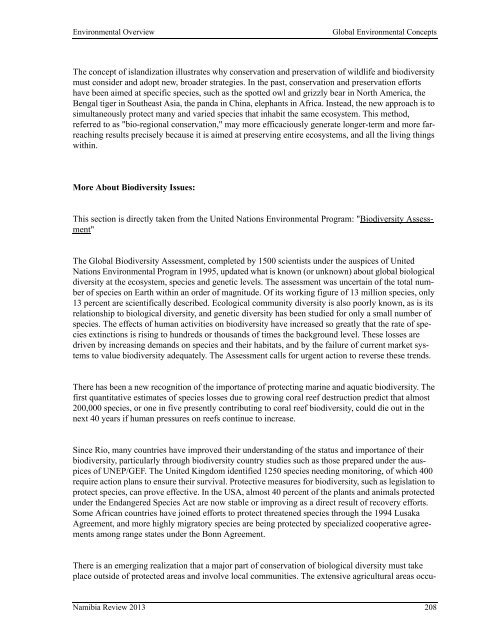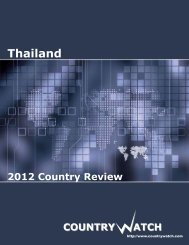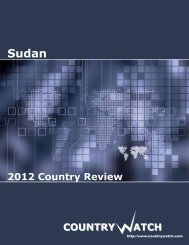Namibia - CountryWatch
Namibia - CountryWatch
Namibia - CountryWatch
Create successful ePaper yourself
Turn your PDF publications into a flip-book with our unique Google optimized e-Paper software.
Environmental Overview Global Environmental Concepts<br />
The concept of islandization illustrates why conservation and preservation of wildlife and biodiversity<br />
must consider and adopt new, broader strategies. In the past, conservation and preservation efforts<br />
have been aimed at specific species, such as the spotted owl and grizzly bear in North America, the<br />
Bengal tiger in Southeast Asia, the panda in China, elephants in Africa. Instead, the new approach is to<br />
simultaneously protect many and varied species that inhabit the same ecosystem. This method,<br />
referred to as "bio-regional conservation," may more efficaciously generate longer-term and more farreaching<br />
results precisely because it is aimed at preserving entire ecosystems, and all the living things<br />
within.<br />
More About Biodiversity Issues:<br />
This section is directly taken from the United Nations Environmental Program: "Biodiversity Assessment"<br />
The Global Biodiversity Assessment, completed by 1500 scientists under the auspices of United<br />
Nations Environmental Program in 1995, updated what is known (or unknown) about global biological<br />
diversity at the ecosystem, species and genetic levels. The assessment was uncertain of the total number<br />
of species on Earth within an order of magnitude. Of its working figure of 13 million species, only<br />
13 percent are scientifically described. Ecological community diversity is also poorly known, as is its<br />
relationship to biological diversity, and genetic diversity has been studied for only a small number of<br />
species. The effects of human activities on biodiversity have increased so greatly that the rate of species<br />
extinctions is rising to hundreds or thousands of times the background level. These losses are<br />
driven by increasing demands on species and their habitats, and by the failure of current market systems<br />
to value biodiversity adequately. The Assessment calls for urgent action to reverse these trends.<br />
There has been a new recognition of the importance of protecting marine and aquatic biodiversity. The<br />
first quantitative estimates of species losses due to growing coral reef destruction predict that almost<br />
200,000 species, or one in five presently contributing to coral reef biodiversity, could die out in the<br />
next 40 years if human pressures on reefs continue to increase.<br />
Since Rio, many countries have improved their understanding of the status and importance of their<br />
biodiversity, particularly through biodiversity country studies such as those prepared under the auspices<br />
of UNEP/GEF. The United Kingdom identified 1250 species needing monitoring, of which 400<br />
require action plans to ensure their survival. Protective measures for biodiversity, such as legislation to<br />
protect species, can prove effective. In the USA, almost 40 percent of the plants and animals protected<br />
under the Endangered Species Act are now stable or improving as a direct result of recovery efforts.<br />
Some African countries have joined efforts to protect threatened species through the 1994 Lusaka<br />
Agreement, and more highly migratory species are being protected by specialized cooperative agreements<br />
among range states under the Bonn Agreement.<br />
There is an emerging realization that a major part of conservation of biological diversity must take<br />
place outside of protected areas and involve local communities. The extensive agricultural areas occu-<br />
<strong>Namibia</strong> Review 2013 208




